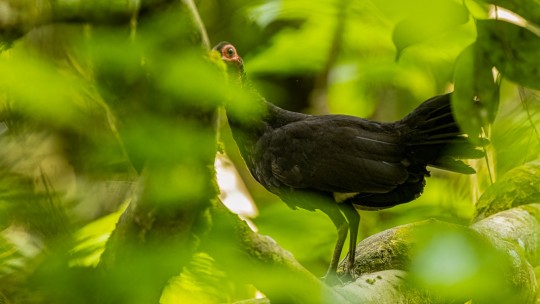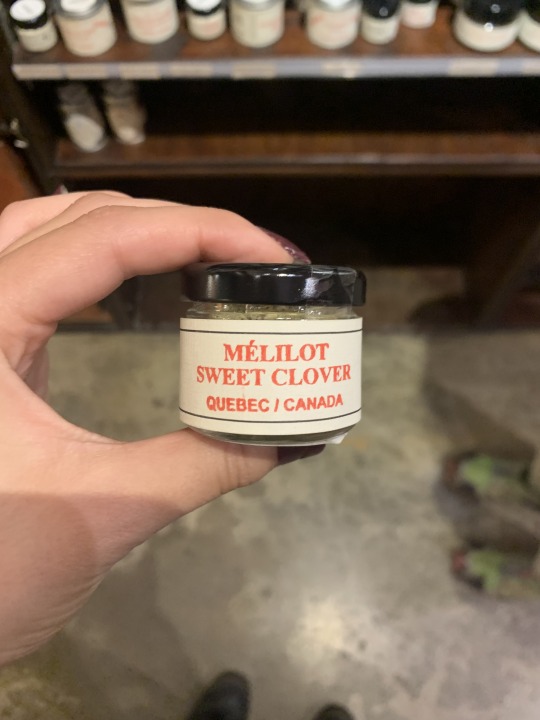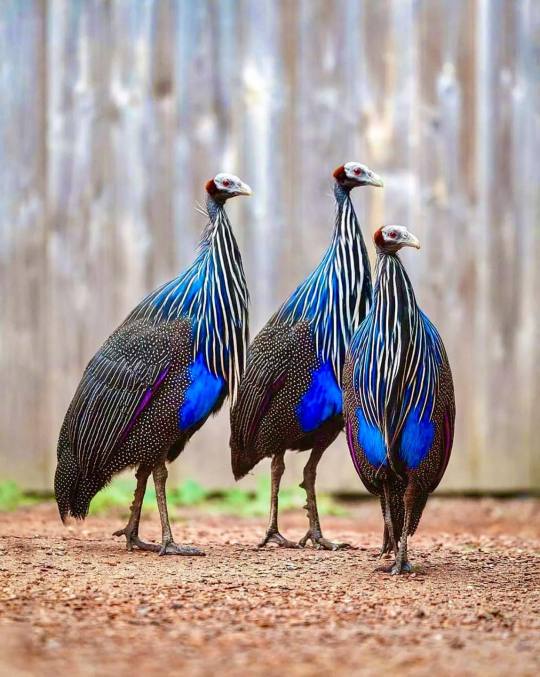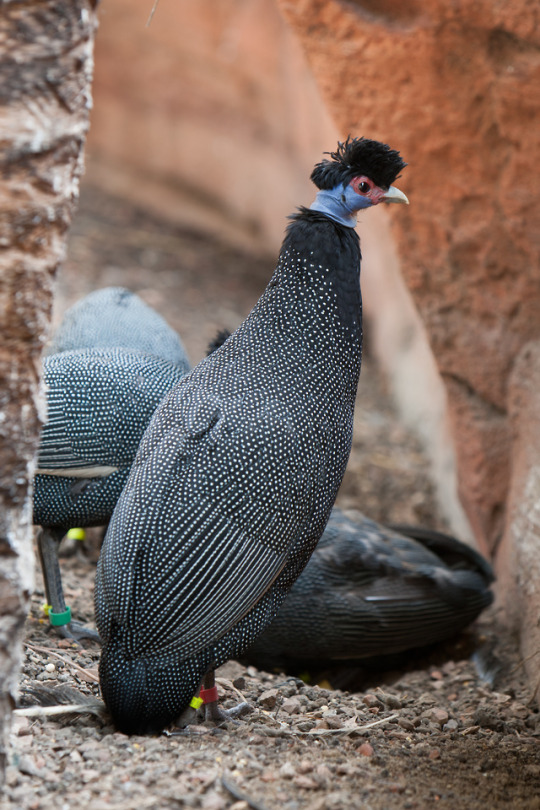#numididae
Text

Vulturine Guineafowl (Acryllium vulturinum), family Numididae, found in northern and central Africa
photograph via: @rockjumper_birding_tours
2K notes
·
View notes
Text

Helmeted Guineafowl
67 notes
·
View notes
Text

[828/10,977] Black Guineafowl - Agelastes niger
Order: Galliformes
Family: Numididae (guineafowl)
Photo credit: Robert Tizzard via Macaulay Library
12 notes
·
View notes
Photo

Helmeted Guineafowl (Numida meleagris)
Family: Guineafowl Family (Numididae)
IUCN Conservation Status: Least Concern
Widely distributed across Sub-Saharan Africa, Helmeted Guineafowl (singular and plural) are easily recognized thanks to their striking spotted bodies, featherless blue-skinned heads and namesake bony "helmets” (which are short and rounded in females and taller and sharper in males.) Spending the day foraging on the ground and roosting in the branches of trees at night, members of this species favour dry, open habitats and live in large flocks throughout most of the year, breaking up into mating pairs during the spring breeding season (with both parents working in shifts to incubate their eggs, which resemble speckled Chicken eggs and are laid on the ground in ditches lined with twigs and leaves, and to raise their chicks, which are known as keets and are born without the helmets of adults) and returning to larger groups after their chicks have fledged in the late summer. The diet of Helmeted Guineafowl varies seasonally; throughout most of the year they feed largely on grasses, seeds, bulbs and roots, but as their nutritional needs change during the breeding season small animals such as insects, arachnids, snails and small vertebrates become more prominent in their diet - in particular, they are known to feed on large numbers of grass-dwelling ticks during the spring, and in doing so benefit other animals within their range by limiting the ability of ticks to spread between hosts and transfer diseases. While foraging in groups Helmeted Guineafowl vocalize near-constantly to notify their flockmates of their presence, and at the first sign of one of their many predators (including Leopards, Servals and a wide range of large snakes and birds-of-prey) the first individual to spot it will produce an extremely loud alarm call, prompting the group to scatter and run for shelter (although members of this species can fly in short bursts, they are far more capable on the ground and will only take to the air as a last resort.) Both within their home range and throughout the wider world captive populations of Helmeted Guineafowl have been farmed for their meat and eggs for centuries, allowing escaped feral populations to have become established in parts of Australia, Europe and North America.
--------------------------------------------------------------------------
Image Source: https://www.inaturalist.org/taxa/1428-Numida-meleagris
#Helmeted Guineafowl#guineafowl#bird#birds#galliformes#landfowl#zoology#biology#ornithology#animal#animals#wildlife#african wildlife
55 notes
·
View notes
Text

The helmeted guineafowl (Numida meleagris) is the best known of the guineafowl bird family, Numididae, and the only member of the genus Numida. It is native to Africa, mainly south of the Sahara, and has been widely introduced, as a domesticated species, into the West Indies, North America, Colombia, Brazil, Australia and Europe.
3 notes
·
View notes
Text
SORTIE 2: Marché Atwater

Malgré le fait que je vais plusieurs fois par année au Marché Jean-Talon, lorsque j’y vais, je sais ce que je chercher et je ne regarde pas tous les produits qui se trouvent autour de moi. En consacrant ma sortie au Marché à la découverte de nouveaux produits, je me suis retrouvée assez surprise. Il y a plusieurs enseignes de magasins que je connaissais mais n’étais jamais rentrée à l’intérieur, j’en ai donc profité pour faire un grand tour. J’ai découvert toutes sortes d’épices très intéressante qu'il me tarde d’essayer, ainsi que plusieurs fruits et légumes qui m’étaient méconnus. J’ai acheté quelques petites choses provenant des magasins et des comptoirs de bouffe pour savourer des gouts nouveaux.
La prochaine fois que j’y retournerais, je vais garder l’œil ouvert et prendre mon temps en faisant le tour du Marché. J’ai bien hâte d’essayer de nouveaux aliments.
Aliments inconnus:






Pommette royale: Vient de pommetiers et a un goût acidulé-sucré. La pommette royale se mange crue, en compote ou en gelée. Elle est également bien aimée des oiseaux.
Pintade: Oiseau de la famille des Numididae venant d'Afrique. La pintade se nourrit de graines et d'insectes. Cuite, la viande est tendre et pleine de goût. Peut se manger rôtie ou au four. Peut se conserver au congélateur entre 6-9 mois.
Royogourt: Yaourt fait à partir de lait de brebis qui contient plus de calories et de protéines. Texture plus ferme et soyeuse qui ressemble à celle du yaourt grec. Le goût est différent de celui du yaourt de vache, il est plus acidulé et prononcé. On peut le manger nature ou le cuisiner.
Méliot: Épice venant d'une plante sauvage qui pousse au Québec. Se cueille en été pour ensuite sécher et créer cette poudre. La plante de mélilot blanc crée des petites fleurs qui, une fois séchée, donne l'épice. L'épice est utilisée principalement en pâtisserie. Le mélilot a des arômes de vanille, de cerise, d'amande, de foin et de fève du Tonka. Le mélilot peut aussi servir en guise d'infusion de tisane ou dans les crèmes pour gâteaux.
Pink Banana: Courge cultivée au Québec ayant un goût sucré et une touche de noisette. La courge contient une couche généreuse de cher. On peut la cuisiner en potage, gratin, purée, dessert, en confiture ou la manger crue.
Rados Melon: De la famille des brassicacées, le radis melon est de couleur verte à l'extérieur et de couleur rose à l'intérieur. Ce radis est doux au goût et croquant. La peau du radis doit être pelée car elle est trop dure. Celui-ci peut se manger froid ou chaud, nature ou assaisonné, en carpaccio ou rôti. Le radis-melon peut se conserver dans un sac plastique troué jusqu'à 3 mois au réfrigérateur. On peut transformer le radis-melons en marinade ou même le déshydrater.
0 notes
Text
Giới thiệu về gà Lông Voi

Gà Lông Voi, còn được gọi là gà Vulturine hoặc gà lông công, là một loại gà hoang dã có ngoại hình đặc biệt và thuộc về họ Numididae. Chúng có nguồn gốc từ khu vực Đông Phi, chủ yếu là các quốc gia Kenya và Ethiopia. Gà Lông Voi được đặt tên theo vẻ ngoại hình của chúng, với một bộ lông đặc trưng giống như lông của voi.
Đặc điểm nổi bật của gà Lông Voi bao gồm:
Bộ lông độc đáo: Lông của chúng có màu sáng, với các vẻ hoa văn và sọc đa dạng màu đen, trắng và xám. Điều này tạo nên một vẻ đẹp rất riêng biệt.
Kích thước lớn: Gà Lông Voi là một trong những loài gà lớn nhất, với chiều dài trung bình từ đầu đến đuôi khoảng 60-70 cm và cân nặng khoảng 2-3 kg.
Điểm đặc biệt trên đầu: Chúng có một mảng da lớn màu đỏ bao phủ đỉnh đầu, kết hợp với mắt lớn và cổ dài.
Chất lượng sống còn cao: Gà Lông Voi có khả năng sống sót tốt trong môi trường khắc nghiệt của vùng hoang dã Đông Phi. Chúng thường sống thành đàn và thích ăn cỏ, hạt và côn trùng.
Tiếng kêu độc đáo: Tiếng kêu của gà Lông Voi không giống bất kỳ loài gà nào khác, thường được mô tả như âm thanh vang vọng, hội tụ và sâu lắng.
Do vẻ đẹp và sự độc đáo của bộ lông, gà Lông Voi thường được nuôi trong các vườn thú hoặc làm vật nuôi trong một số nơi trên thế giới. Tuy nhiên, chúng vẫn đang gặp rủi ro từ việc mất môi trường sống và săn bắn trái phép.
0 notes
Photo

Helmeted Guineafowl (Numida meleagris)
© Dubi Shapiro
106 notes
·
View notes
Photo

Plumed Guineafowl (Guttera plumifera)
© Arjan Haverkamp
91 notes
·
View notes
Photo

Crested Guineafowl (Guttera pucherani)
© J. Christopher Haney
48 notes
·
View notes
Photo

Helmeted guineafowl (Numida meleagris) in Namibia
Gregory Smith
43 notes
·
View notes
Text

Vulturine Guineafowl (Acryllium vulturinum), family Numididae, order Galliformes, found in northern and central Africa
This bird is the only member of this genus.
photograph by cherelleoverklift
455 notes
·
View notes
Photo

Plumed Guineafowl (Guttera plumifera)
© Jacques Erard
5 notes
·
View notes
Link
#vulturine guineafowl#acryllium vulturinum#numididae#galliformes#galloanserae#bird#dinosaur#modern dinosaurs#animal behavior#multilevel society
220 notes
·
View notes
Photo

Guttera plumifera by Arjan Haverkamp
#bird#birds#animal#animals#biology#nature#wildlife#fauna#Galliformes#Numididae#Guttera#Guttera plumifera
95 notes
·
View notes
Video
youtube
2 Rupee Commemorative Coins Part 1|| இரண்டு ரூபாய் நினைவான வகை நாணய வகைக...
#IndianHobbyTamil#2 Rupee Commemorative Coins#2 Rupee National Integration Coins#2 Rupee Asian Games Coins#1982 Asian Games Coins#1990 National Integration Coins#1982 National Integration Coins#Commemorative Coins Of India#Commemorative Coins#numididae#Numis#Numismatic#numismatique#Coins#Coin#Old India Coin#Unique Coins
1 note
·
View note